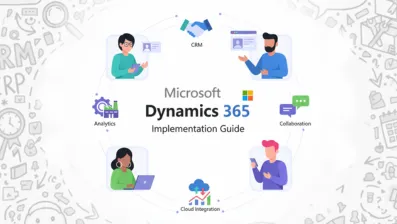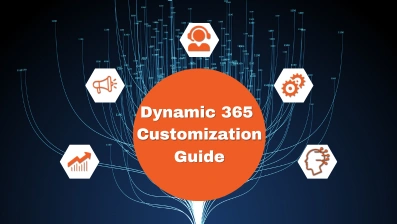When a business plans to bring in new software, the first thing most people think about is cost. The same is true for Microsoft Dynamics 365. Before you start using it, it is important to know how much the setup will cost and what factors can change that price.
Dynamics 365 helps companies manage sales, customer service, accounts, and daily tasks in one place. It can make work faster and more organized. But the Dynamics 365 implementation cost is not the same for everyone. It changes based on your business size, how many people will use it, and how much you want to customize it.
When you understand the cost early, you can plan better. It helps you decide what your business really needs and what can wait for later. On average, the cost of Microsoft Dynamics 365 development ranges from $20,000 to $500,000 or even more.
In this blog, we will look at how the cost works, what affects it, and how you can save money while still getting all the benefits of Dynamics 365 for your business.
What Is Microsoft Dynamics 365?
Microsoft Dynamics 365 is a set of business tools that help companies manage all their work in one common platform. It is made by Microsoft to help both small and large businesses handle their daily tasks more easily.
It combines two main systems: CRM and ERP.
CRM means Customer Relationship Management, which helps manage customers, sales, and service.
ERP means Enterprise Resource Planning, which helps handle accounts, inventory, and business operations.
Many companies use different software for different departments, which makes work slow and confusing. Dynamics 365 solves this problem by bringing everything together in one system.
The integrated system helps teams work better together, share information quickly, and save time. For example, if the sales team adds a new customer, the finance team can see it right away without waiting for reports or emails.
It also connects easily with other Microsoft tools like Outlook, Teams, and Power BI. This makes it simple for employees to work without switching between different apps. In short, Microsoft Dynamics 365 helps businesses stay organized, work faster, and make smarter decisions every day.
Dynamics 365 Implementation Overview
The process of setting up Microsoft Dynamics 365 is called implementation. It means preparing and customizing the system so it works the way your business needs it to.
An effective and well-planned setup helps your team work faster, stay organized, and use the system without confusion.
Steps to properly implement Microsoft Dynamics 365 for your business:
Step 1: Planning
The first step is planning. In this stage, you and your Dynamics 365 implementation partner talk about your goals and what you want the system to do. You choose the tools that fit your business, like CRM for managing customers or ERP for handling finance and operations.
Planning also helps you decide your budget, timeline, and the number of users who will need access.
Step 2: Design and Setup
After planning, the system is designed and set up. This includes creating forms, reports, and dashboards that match your daily work. The goal is to make the system simple and useful for your team.
Step 3: Data Migration
Next comes data migration. This is when your old data, such as customer details or sales records, is moved into Dynamics 365. The data is cleaned and checked before it is added so that users can trust the information from the start.
Step 4: Testing and Training
Once the data is ready, the system is tested to make sure everything works properly. Any issues are fixed. After that, your team is trained so they know how to use the system with confidence.
Step 5: Go-Live and Support
After training, your system goes live. From this point, your business starts using Dynamics 365 for real tasks. The partner continues to support your team, fix problems, and make updates when needed.
Cost to Implement Dynamics 365
The Dynamics 365 implementation cost changes from one business to another. It depends on your company size, number of users, and how many tools or features you need.
You can prefer starting small with only a few modules, while others might look for a complete system that connects every department.
Here is a simple breakdown of how much the setup may cost for small, medium, and large companies. It can help you get a better understanding of the direction in which to proceed.
1. Small Businesses – Basic CRM or ERP Setup
Small companies usually need simple tools to manage customers, sales, and daily work. Hence, they opt for a basic approach, for which the average cost ranges between $20,000 and $50,000.
This setup commonly includes:
One or two Dynamics 365 modules, such as CRM or ERP
Ready-to-use dashboards and reports
Basic data import from older systems
Standard Microsoft integrations, such as Outlook or Excel
Short user training sessions
This is a considerable option for startups or small teams who want to move from manual work to digital tools without spending too much money.
2. Mid-Sized Enterprises – Multi-Module Customization
Mid-sized businesses often have more departments and more data to manage. Hence, they need additional tools, automation, and reports.
Such integrations result in an increased cost compared to a small business solution, and the cost ranges between $50,000 and $150,000.
This setup may include:
Multiple modules, such as Sales, Finance, and Operations
Custom dashboards, forms, and workflows
Full data migration with cleaning and mapping
Cloud hosting setup and configuration
Role-based permissions and access levels
Complete user training and go-live support
This setup helps mid-size companies bring all teams together, improve efficiency, and plan for future expansion.
3. Large Enterprises – Full-Scale Deployment with Integrations
Large companies often need a system that connects global teams and supports complex operations. The cost can range between $150,000 and $500,000 or more, depending on the level of customization.
This setup may include:
Full implementation of all Dynamics 365 modules across departments
End-to-end data migration and testing
Integration with other systems like HR, Payroll, and BI tools
Automation for advanced reporting and analytics
Custom user interfaces and security controls
Long-term support and maintenance after launch
This is the best choice for large-scale or multinational enterprises that want complete control, better security, and large-scale performance.
4. Detailed Dynamics 365 Cost Comparison Table
The cost aspect is summarized in the table below for a better understanding:
Business Size | Modules Included | Main Features | Customization Level | Training & Support | Estimated Cost (USD) |
Small Business | 1–2 (CRM or ERP) | Contact management, reports, billing, basic tools | Low | Basic user training | $20,000 – $50,000 |
Mid-Sized Business | 3–5 (Sales, Finance, Operations, Customer Service) | Custom dashboards, workflows, and data migration | Medium | Full team training, go-live help | $50,000 – $150,000 |
Large Enterprise | 5+ (All major modules + integrations) | Global setup, automation, third-party connections, and advanced reports | High | Long-term support and updates | $150,000 – $500,000+ |
These costs are only estimates and can change based on the partner you work with, your data volume, and the number of users. A trusted Dynamics 365 implementation partner can help you plan the project, manage your budget, and select only the tools that truly fit your business.
Factors That Influence Dynamics 365 Implementation Cost
The Dynamics 365 implementation cost is different for every business. It depends on what your company needs, how big your team is, and how much setup work is required. Knowing what affects the cost helps you plan better and use your budget wisely.
Below are the main factors that significantly impact your Dynamics 365 setup budget.
1. Organization Size and User Count
The bigger your company, the higher the cost. A small business with a few users will pay less than a large company with hundreds of users. More users mean more licenses, more setup work, and more training.
For example, a small team may only need a few modules and short training sessions. On the other hand, a large team might look for separate tools for each department and more time for setup. Accordingly, the cost varies.
2. Customization Level
Every business works differently. Some use the basic version of Dynamics 365, while others want custom dashboards, workflows, and reports. The more changes you make to the system, the more the cost increases.
Custom setups take more time and need extra testing. If your goal is to save money, start with built-in features and add new ones later. Using ready-made tools first helps you get started quickly without large costs.
3. Deployment Model (Cloud or On-Premise)
You can use Dynamics 365 in two main ways: on the cloud or on your own company servers.
The cloud version has a lower starting cost and is easier to manage. It also includes regular updates and security from Microsoft.
The on-premise version costs more initially because you must buy and maintain your own servers. However, some companies prefer it if they want full control over their data.
4. Data Volume and Complexity
The amount of data you need to move into Dynamics 365 can affect the total cost. If you have years of records, reports, and customer details, the migration process will take more time and effort.
Before the data is moved, it has to be cleaned and organized. Clean and correct data helps your team work better from day one. The more complex or messy your old data is, the higher your migration cost will be.
5. Third-Party Integrations
Many companies want to connect Dynamics 365 with other tools such as HR software, marketing apps, or reporting systems.
These extra connections are called integrations. They make your system more powerful, but they also add to the cost.
Each integration must be tested to make sure the data moves safely between systems. Choosing only the most important integrations at first can help you manage your budget and still get good results.
6. Vendor Expertise
The experience of your implementation partner also affects your overall cost. A skilled Dynamics 365 implementation partner might charge more, but they usually save time and help you avoid costly mistakes.
It is better to choose a trusted web development company that understands your business and gives you full guidance from start to finish.
Cloud vs On-Premise Implementation Cost Comparison
When you plan to set up Microsoft Dynamics 365, one of the biggest choices you will make is how to host it. You can either use the cloud version or install it on your own company servers, which is called on-premise.
Both options do the same job, but the cost, setup, and maintenance are very different. Understanding how each approach works will help you pick the one that fits your business the best.
1] Cloud Implementation
In a cloud setup, your Dynamics 365 system runs on Microsoft’s online servers. You pay a monthly or yearly fee to use it, rather than buying the system outright. This setup is simple because Microsoft handles most of the work for you.
They take care of updates, data security, and storage, so you do not have to worry about maintaining any servers or equipment. The setup cost for the cloud version typically ranges from $15,000 to $40,000.
The monthly fee can range between $95 and $210 per user, depending on which modules you use. This cost covers system updates, maintenance, and technical support. You do not need a big IT team to run the system, which also helps save money over time.
The cloud version works well for small and mid-sized companies. It has a lower starting cost, is quick to set up, and makes it easy to add more users or modules as your business grows.
It is also good for remote teams because it can be accessed from anywhere with an internet connection. The only downside is that you will need a stable internet connection, and there are ongoing monthly costs.
2] On-Premise Implementation
With an on-premise setup, your company hosts Dynamics 365 on its own servers. You buy the license once and install everything within your organization. This gives you full control over your data and customization.
However, it also means you must take care of system maintenance, updates, and backups on your own.
The setup cost for on-premise implementation can range between $50,000 and $200,000, depending on how large your company is and how many modules you want.
You will also need to spend about $10,000 to $50,000 on servers and hardware. Maintenance, data backups, and IT support can cost around $20,000 to $60,000 per year.
The on-premise version is best for large companies that already have their own IT team and want to keep all data within their own network. It also suits businesses that have strict security policies or limited internet access.
3] Choosing What’s Right for You
If you want a fast, flexible, and low-maintenance setup, the cloud version is the better choice. It saves time and effort while offering strong security and easy access from anywhere.
Further, when your company scales, and you need full control, more customization, or strict data security, the on-premise version is a better fit, even though it costs more upfront.
A trusted Dynamics 365 implementation partner can guide you in choosing the right model for your budget, data needs, and long-term goals.
Category | Cloud Implementation | On-Premise Implementation |
Initial Investment | $15,000 – $40,000 | $50,000 – $200,000 |
Monthly Cost | $95 – $210 per user | None (one-time license) |
Maintenance Cost | Included in subscription | $20,000 – $60,000 per year |
Hardware Cost | None | $10,000 – $50,000 |
Updates | Automatic by Microsoft | Manual, done by the IT team |
Security | Managed by Microsoft | Managed by your company |
Best For | Small and medium businesses | Large enterprises with IT staff |
Hidden Costs You Shouldn’t Ignore
When you plan for a Dynamics 365 implementation, it is normal to focus on setup, customization, and training costs. But there are some hidden costs that many companies forget to plan for.
These small but important expenses can add up and affect your overall budget if you are not careful. Knowing about them in advance can help you plan better and avoid last-minute surprises.
► Change Management
When a new system is introduced, your team will need time to adjust. Some people may find it hard to change the way they work, especially if they have used the old system for years.
Helping your employees accept the new system takes effort, time, and sometimes extra money and cost. You may need to hold short training sessions, share easy guides, or run feedback meetings to help everyone get used to the changes.
Good communication makes this step easier. If people understand why Dynamics 365 is being used and how it will help them, they are more likely to support it.
► User Training
Training is often a hidden cost that companies forget to include in their budget. Even if the software is easy to use, your team still needs time and support to learn how to use it correctly.
Most vendors include only basic training in their main package, but deeper or ongoing sessions often cost more.
If you have a large team, the cost can increase quickly because more people need attention. To reduce this, you can train a few key employees first. These employees can later teach others and handle small issues themselves. This approach saves both time and money.
► Post-Implementation Support
Once the system is live, your work does not stop. You may face small issues, need updates, or require changes to fit new business needs. Some vendors include limited support after launch, but long-term help usually comes with extra charges.
Planning for post-implementation support ensures your Dynamics 365 system stays reliable and runs smoothly. Without it, your team may face delays if something goes wrong and help is not immediately available.
► Third-Party Plugins and Add-ons
Sometimes the default tools in Dynamics 365 are not enough. You might need extra plugins or apps for reports, email automation, or analytics. These add-ons can improve your system, but also increase your costs.
Start with only the features you truly need. You can always add more later when your team is comfortable with the system. This approach keeps your costs in check while still giving you the tools you need to grow.
Hidden costs are not always easy to spot, but they are an important part of your planning. A good Dynamics 365 implementation partner will help you identify these expenses early, so your project stays on budget and runs smoothly from start to finish.
How to Reduce Dynamics 365 Implementation Costs?
Setting up Microsoft Dynamics 365 can be a big investment, but there are many ways to keep the cost under control. With a clear plan and the right help, you can save money and still build a system that fits your business.
The goal is not to spend less but to spend smart so you get the best results for every dollar you pay.
A] Work with the Right Partner
One of the best ways to reduce your cost is to work with a trusted Dynamics 365 implementation partner. A trusted partner knows how to set up the system without wasting time or resources.
An experienced partner also helps you avoid common mistakes that can lead to extra costs, such as wrong data setup or poor planning. Choosing the right team in the beginning saves both time and money later.
B] Start Small and Expand Later
You do not have to set up everything at once. Start with a few key modules that will make the biggest difference to your business.
For example, if your goal is to improve sales and customer tracking, begin with CRM. Once your team gets comfortable, you can add other parts like finance, operations, or reporting.
This step-by-step approach helps your team learn faster, reduces pressure, and keeps your spending balanced over time.
C] Use Built-In Features
Dynamics 365 comes with many ready-to-use tools, templates, and reports. These can save you a lot of time and customization costs. Before asking for new features, check if the system already offers what you need.
Many businesses spend extra money building tools that already exist inside the platform. Using built-in features first helps you save money and makes setup faster.
D] Train Key Employees
Training your whole team can be expensive, especially in large companies. A smart way to manage this is by training a few key employees first.
These employees can later help others learn. This way, you build internal experts who can solve small problems without depending on outside help. This approach reduces repeated training costs and makes your team more confident.
E] Use Microsoft’s Fast Track Program
Microsoft provides a free program called Fast Track to help companies deploy Dynamics 365 smoothly. It includes training guides, tools, and direct help from Microsoft experts. Many companies use this program to save both time and consulting fees.
ROI Analysis: Is Dynamics 365 Implementation Worth the Cost?
When businesses hear about the Dynamics 365 implementation cost, many wonders if it is really worth spending so much money.
The following factors can help you decide whether the investment is worth it for your business or not.
1. Better Efficiency and Time Savings
One of the biggest returns from Dynamics 365 is better efficiency. The system helps your teams work faster by bringing everything together in one place. Your sales, finance, and customer support teams can all access the same data. This reduces confusion, stops duplication, and saves a lot of time.
2. Stronger Decision-Making
Another benefit is better decision-making. Dynamics 365 gives real-time information about sales, performance, and customer behavior. Instead of guessing or waiting for long reports, business leaders can see what is happening right away. This helps them act faster and make smarter choices.
3. Happier Customers
When your team has quick access to customer data, they can serve people faster and more personally. For example, when a support agent can see a customer’s full history, they can solve issues more easily. This kind of quick and caring service builds trust and keeps customers happy. Happy customers are more likely to stay with your business and recommend it to others.
4. Long-Term Value
At first, the setup cost for Dynamics 365 may seem high, but the long-term value is much greater. Once the system is running smoothly, it saves time, improves teamwork, and reduces manual work. Automation cuts down on errors and makes daily tasks easier. Over the years, these small improvements add up to big savings.
How Can DotStark Help With Implementation?
Setting up Microsoft Dynamics 365 can feel complex, but with the right partner, the process becomes much easier.
DotStark, as a Microsoft Dynamics 365 consulting company, is here to help you at every step, from planning to final setup. We take the time to understand your business needs and build a system that fits your goals.
We start by learning about your company, your team, and the challenges you face. Then we design a Dynamics 365 setup that works best for you. Our experts help with data migration, system customization, and user training. We make sure everything runs smoothly, so your team can start using the system without confusion or delay.
Even after the system goes live, we continue to support you. We help with updates, new features, and performance checks to keep everything working perfectly. If something needs fixing or improving, our team is always ready to step in.
As a leading Microsoft Dynamics 365 development company, we focus on making sure your investment pays off. Our goal is simple, i.e., to help your business run better, faster, and more confidently with a system that grows along with you.
Conclusion
The Dynamics 365 implementation cost may seem like a big number at first, but what truly matters is the value it brings to your business. When planned and managed the right way, Dynamics 365 is not just an expense, but an investment that helps your company grow, work faster, and stay organized.
The key is to find the right balance between cost and value. Focus on what your business really needs and avoid spending money on features that are not useful right now. With the right Dynamics 365 implementation partner, you can design a system that fits your goals, supports your team, and delivers long-term results.
It can be concluded that Dynamics 365 is more than software. It is a complete business solution that helps your company stay efficient, connected, and ready for the future. With smart planning and expert support, it can turn your investment into lasting success.
Frequently Asked Questions
The Dynamics 365 implementation cost changes based on your company's size and needs.
For small businesses, it usually costs between $20,000 and $50,000.
Mid-sized companies spend around $50,000 to $150,000,
Large companies may spend $150,000 or $500,000 more.
The total cost also depends on how many users you have, how much data you move, and how customized your setup needs to be.
The time needed to set up Microsoft Dynamics 365 depends on the size of your project. A small setup can take around two to three months. A full setup with more users and features can take six months or longer.
Several factors affect how much you spend on Dynamics 365. These include your company size, number of users, customization needs, and whether you choose cloud or on-premise hosting. The amount of data you move and the training your team needs also matter at large.
Microsoft Dynamics 365 helps businesses manage all their work in one place. It brings together sales, finance, and customer service, making it easier for teams to share data and work faster. It also provides real-time reports that help you make better decisions. Over time, it helps sav
Choosing the right Dynamics 365 implementation partner is very important. Look for a team that understands your business and has experience with similar projects. They should be clear about their process, timeline, and support. A good partner will listen to your needs, set up the system correctly, and guide you even after launch to make sure everything runs smoothly.
.webp)

.webp)




 +91 9680599916
+91 9680599916
 vanshika@dotstark.com
vanshika@dotstark.com
